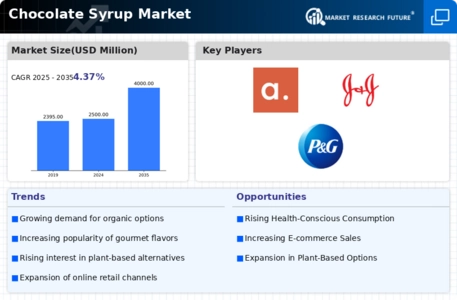Chocolate Syrup Size
The chocolate syrup market is influenced by several key factors that collectively contribute to its growth and dynamics. One significant driver is the enduring popularity of chocolate-flavored products among consumers of all ages. Chocolate syrup, with its rich and indulgent flavor, serves as a versatile topping for desserts, ice creams, and beverages. The universal appeal of chocolate contributes to a consistent demand for chocolate syrup across diverse demographics, making it a staple in many households.
Changing consumer preferences and lifestyle choices also play a pivotal role in shaping the chocolate syrup market. As consumers become more health-conscious, there is a growing demand for healthier and natural ingredients in food products. Market trends reflect a shift towards chocolate syrups with reduced sugar content, organic formulations, and clean-label attributes. Manufacturers are adapting to these preferences by introducing healthier alternatives, such as sugar-free or low-calorie chocolate syrups, to cater to the evolving tastes of health-conscious consumers.
The food and beverage industry's emphasis on innovation and product diversification contributes significantly to the chocolate syrup market. Manufacturers are continually introducing new flavors, formulations, and packaging innovations to capture consumer attention. Chocolate syrup is not only used as a topping but also as an ingredient in various recipes and beverages, expanding its application and market reach. The ability to offer innovative and versatile chocolate syrup options allows companies to stay competitive and meet the dynamic demands of consumers.
Economic factors, including disposable income and purchasing power, also influence the chocolate syrup market. In periods of economic stability and rising incomes, consumers are more willing to spend on indulgent and premium products, including high-quality chocolate syrups. Conversely, during economic downturns, there may be a shift towards more cost-conscious choices. Manufacturers need to consider these economic dynamics and tailor their marketing strategies to align with consumer spending patterns in different economic conditions.
Global cocoa production and supply chain logistics are critical factors affecting the chocolate syrup market. Fluctuations in cocoa prices, weather conditions impacting cocoa crops, and supply chain disruptions can influence the overall cost and availability of chocolate syrup. Market participants must closely monitor these factors to manage production costs, ensure a stable supply chain, and mitigate potential impacts on pricing and product availability.
The influence of cultural and seasonal factors also shapes the chocolate syrup market. In many cultures, chocolate is associated with celebrations, holidays, and special occasions, leading to increased demand during festive periods. Seasonal variations, such as higher consumption during winter months for hot chocolate or summer for ice cream toppings, affect market trends. Manufacturers often capitalize on these cultural and seasonal preferences by launching limited-edition or themed chocolate syrups to boost sales during specific periods.
Distribution channels and retail partnerships are crucial elements in the chocolate syrup market. The accessibility of chocolate syrup products through supermarkets, convenience stores, and online platforms impacts consumer reach and market penetration. Collaborations with retailers and effective distribution strategies contribute to the visibility and availability of chocolate syrup, influencing purchasing decisions and brand loyalty.








Leave a Comment